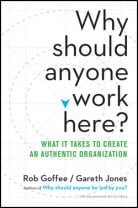By Rob Goffee and Gareth Jones, authors of Why Should Anyone Work Here?
The challenge of finding, training, and retaining excellent workers has always been with us. But meeting that challenge today requires a seismic shift in the employee-employer relationship.
The need for organisations to develop their human capital will not come as big news to anyone. It has long been recognised by elite knowledge-intensive businesses like Goldman Sachs, McKinsey, and Johns Hopkins Hospital. More recent examples include Microsoft, Google, and Apple. But we contend that this process is not confined to specialised, high-tech, or high-finance organisations or occupations.
It will increasingly become characteristic of the wider employment relationship, including in traditional ‘blue-collar’ industries and franchises such as McDonald’s, whose UK training programme in hospitality and catering awards employees with nationally recognised academic qualifications.
In the authentic organisation, rather than ceaselessly extracting value from employees, ‘extra’ value is added.
The ideal company doesn’t just grow its best employees; it makes all its employees better than they ever thought they could be. Rather than thinking about how much they can get out of every person, these organisations think about how much they can magnify their strengths. At heart, that’s what productivity improvement really means. High-productivity organisations are typically distinguished by continuous investment in their people.
The ideal company doesn’t just grow its best employees; it makes all its employees better than they ever thought they could be
This is an apparently simple idea and yet it is surprising that in the second decade of the twenty-first century, so few organisations have fully embraced its implications. At the most basic level of why adding value matters to organisations and individuals, there is a mountain of studies linking investment in the various types of human capital with job satisfaction, productivity, greater retention, lower turnover, and other benefits.

Rob Goffee
This in turn is linked with customer retention and satisfaction. Interestingly, the link with performance is often explained in terms of inducing employee discretionary behaviour. This means that magnifying employees’ strengths results in workers who do more, better, and more innovatively. Linking all of this causally to financial performance (e.g., profitability or shareholder value) is more difficult, mainly because of time-lag effects and intervening variables. But over the long term, there is a correlation between financial performance and investment in human capital.
But organisations need to ask what value means, and how is it added? What forms does it take, and how is it developed? And who in the organisation is responsible for making sure employees receive added value?
We can think of each type of value as representing one of three categories of skills: technical, conceptual, or human.
Technical skills are typically understood as job-specific knowledge and techniques that individuals require to fulfill their work tasks. Much of this learning takes place on the job and is the responsibility of line executives, though this process may be accelerated by short, intensive training courses. Technical skills are often a major focus for the development of lower-level employees who need to understand various tools and techniques to produce the organisation’s products and services.
Conceptual skills typically become important in more senior occupations where there is a need to understand the organisation as a whole, the relationships among its parts, and how it connects with its broader environment. These skills are often developed by sending executives to business schools, where they are exposed to the latest thinking on strategy and organisational behaviour.
Human skills, like conceptual skills, traditionally have been seen as increasingly important as a person takes on more managerial responsibilities – which require the individual, in one way or another, to deliver performance through other people. Many organisations start to become concerned with developing human skills only once an employee has taken on a managerial or leadership position. At that point, HR will develop and provide interpersonal-skills programs, and high-potential executives will be increasingly exposed to the top leadership in the hope (often vain) that they will be influenced by the exemplary conduct of their senior leaders. Very smart organisations, however, recognise the significance of human skills throughout the hierarchy – for example, the skill of the bartender who makes eye contact with customers, or the skill of the receptionist at a hotel or bank who makes customers feel significant.
Let’s look at the ways organisations can begin to add value in practice. Note that because in elite knowledge-intensive organisations, the responsibility for development rests mainly with individuals themselves, employees have to be quite proactive in seeking out the knowledge they need and the networks to support them. In the case of LOCOG and McDonald’s, by contrast, we can see strategic HR at its very best.
In both examples the human resource function is at the heart of adding value, and in both cases its success is measured with elaborate and strict metrics.
Interestingly, the HR functions of both organisations exhibit that combination of leading-edge people practices and considerable business “savvy,” which may be the key ingredients of really successful strategic HR.

Gareth Jones
In our surveys, senior executives – perhaps not surprisingly – feel most strongly that they are given the chance to develop and are least convinced that the weakest performers can see ways to improve. Among other employees the strongest-scoring item is ‘We generate value for ourselves by adding value to others’.
This might be explained by the opportunities that are available – even to those in relatively routine operative or service occupations – to exceed role expectations and deliver extra value to consumers or customers.
Note that each of the diagnostic statements implies an important organisational and leadership imperative. In fact, our research uncovered three primary ways that companies can add extra value and magnify their people’s strengths: through opportunities for personal and professional development, by helping stars to shine and weak players to grow, and by leveraging the dynamic inherent in the act of adding value.
Reprinted by permission of Harvard Business Review Press. Excerpted from Why Should Anyone Work Here? – What it Takes to Create an Authentic Organisation. Copyright 2015 Rob Goffee and Gareth Jones. All rights reserved.
About the bloggers
 Rob Goffee is Emeritus professor of organisational behaviour at London Business School, where he teaches in the world-renowned senior executive programme.
Rob Goffee is Emeritus professor of organisational behaviour at London Business School, where he teaches in the world-renowned senior executive programme.
Gareth Jones is a fellow of the Centre for Management Development at London Business School and a visiting professor at Spain’s IE Business School in Madrid.
Goffee and Jones consult to the boards of several global companies and are co-authors of Why Should Anyone Be Led by You? and Clever, both published by Harvard Business Review Press.




